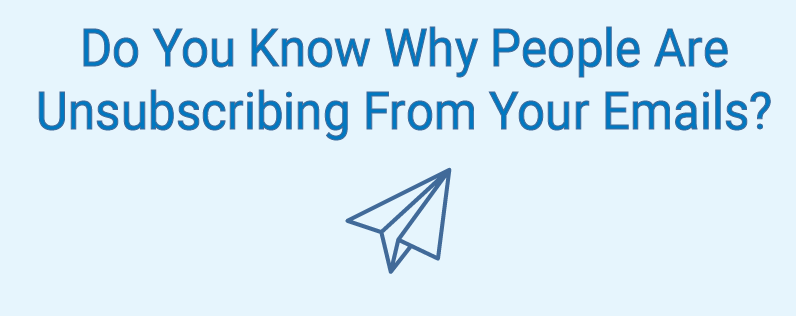
Let’s be honest, no one enjoys having people unsubscribe from their email contact list.
With all the work you put into growing your list and the time you spend designing, creating, and sending emails—it’s never fun when someone decides to say thanks but no thanks.
But while losing contacts is something we all dread, it’s also a reality we all must accept.
Whether you’re an email marketing expert, with years of experience and thousands of contacts on your list or a business owner who’s just getting started—you’re going to have people who decide to unsubscribe from your list.
And while you certainly cannot (and should not) expect people to stay on your list forever, you can certainly learn a lot when they decide to walk away.
It’s not goodbye, it’s just see you later
Having someone unsubscribe from your emails is not the end of the world. And in most cases, it’s not the end of your relationship with that customer or client either.
Customer relationships don’t begin and end with an email signup or unsubscribe. For your customers, signing up for your email list is an added bonus of being a loyal customer. Their reasons for signing up will be different based on their particular needs and interests but overall, joining your list is about making life easier for them.
Just because they opt-out doesn’t necessarily mean they’re done being a customer.
So why are people choosing to opt-out from your list?
We asked 1,400 consumers that very question. Here’s what they had to say:
- 69% Too many emails from the business/organization
- 56% The content is no longer relevant
- 51% The content wasn’t what I expected
As you can see, for these consumers the decision to opt out had less to do with their perception of the business and much more to do with the overall email marketing strategy.
Just as consumers sign up with certain needs and interests, they also sign up with different expectations for what they’re going to receive. When you fail to deliver on those expectations, you lessen the chance of keeping contacts engaged and increase the chance of having them unsubscribe from your list.
How to learn from customers who unsubscribe
While you shouldn’t bang your head against the wall every time someone decides to unsubscribe, you should take the time to better understand the factors that lead to their decision to opt out.
That doesn’t mean confronting them in your store or calling them to ask them to explain themselves. (If their decision to unsubscribe didn’t end their relationship with your business; that most certainly would.)
But there is information readily available to you today, that you can use to develop a better understanding of why people decide to opt out.
First off, you have your reports
Looking at your email reporting is the easiest way to track the effectiveness of your email marketing campaigns. The “positive” metrics like opens and click-through rates allow you to see the type of interest your emails are generating and the type of engagement that’s actually taking place.
The “negative” metrics like opt-outs and spam reports have a lot to teach you about your email marketing as well.
Your opt-out rate shows how many people received an email from your business and made the decision to unsubscribe.
Having a few opt-outs per email, shouldn’t trigger any red flags. In fact, by giving those readers the opportunity to opt-out you’ll likely be improving other metrics because you’ll be removing less unengaged contacts from your list. (We typically say that around 2% is a normal opt-out rate for an email campaign.)
A spike in opt-outs, however, is typically the result of a change that did not go over well with your readers. Remember that the top reasons people unsubscribe are related to frequency, content, and subscriber expectations.
In addition to looking at the content and frequency of your emails, you’ll also want to consider how your list changed over that particular period. If you’ve recently begun sending to a new list of contacts or ran a promotion to help grow your list, there may be a period where some of these contacts decide to opt-out.
But if each time you add a new group of contacts, your opt-out rates for the next email go through the roof, you may need to take a fresh look at the signup process you’re offering consumers. It may indicate readers were expecting something different when they decided to join your list.
You can also ask readers why they’re opting-out when they unsubscribe
This is something business owners often have mixed feelings about. After all, they’ve already unsubscribed, will knowing why really make a difference?
But by giving people the opportunity to provide a reason for opting-out, you’ll not only collect valuable feedback, you’ll also be giving customers the chance to better explain their decision.
Both can go a long way in helping improve your email marketing going forward.
How this feedback can help improve your own email marketing
I recently took a look at one local business’ opt-out rates to see what I could learn. The business is a retail store located in my hometown and I have recently been helping them make some improvements to their email marketing strategy.
Because recent results have been trending in the right direction and opt-out rates have been consistently low, I didn’t expect to see anything that would indicate that major improvements would need to be made.
And for the most part, I was right.
Nearly half of the people who decided to unsubscribe did so based on their proximity to the business—some had recently moved elsewhere and others had signed up while on vacation and no longer needed updates about new products, specials, or events.
The other half were people who unsubscribed based on the volume of emails they were receiving each day. For them the frequency of email—not only from us but from all of the brands they had subscribed to—had become a problem and they needed to scale back on the information coming to their inbox each day.
On one hand, this feedback was reassuring. So maybe we had lost a few contacts, we had also seen a lot of success from the last few campaigns. And what could we really do to keep people on the list that had moved out of state or decided that one email newsletter per month was more than they could handle?
On the other hand, all of the products the business offers in-store are readily available online. Maybe we could have done a better job at promoting e-commerce sales, rather than trying to talk to every reader as if they lived just a few blocks away.
And why couldn’t we offer new contacts the opportunity to sign up to receive emails once a quarter, rather than once a month?
Neither of these changes would have taken much extra work and could have kept at least some of these contacts from opting out from their list.
Small improvements can make a big difference
In most cases, the changes you make from keeping tabs on your opt-outs and collecting feedback from readers who decide to unsubscribe will be small.
Maybe it will mean trying different types of content, revamping the signup experience you’re offering new contacts, or scaling back on the frequency of emails you’re sending your list.
But while these changes may be small, the impact can make a big difference when it comes to maintaining email relationships and driving more results from your email marketing.
I know I’ll be using the lessons I learned to help one of my favorite local businesses, I hope you’ll consider doing the same for yours as well!




